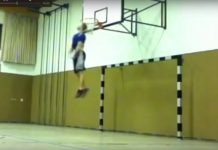What I want to talk to you guys today about the fact that strength is not what makes you more explosive. Strength will not make you necessarily more explosive because strength is about overcoming resistance. But if you’re not teaching your muscles to overcome resistance explosively or very rapidly, you’re only teaching your muscles to move very slowly still but you could push a truck very slowly. Or you could squat a ton of weight very slowly. So strength is not the key to becoming more explosive. Strength is prerequisite. You do need to have strength but it’s not what makes you explosive.
What makes you explosive is the neural patterns of your muscles. You see when you flex your muscle, you contract your muscle, you jump higher for example. You’re sending a neural impulse through your muscles and the faster and more explosive and stronger that impulse is to your muscles, the response to your muscles will be more explosive, faster, stronger.
So how do you train them? How do you teach your body to send a stronger signal to your muscles? Well in Russia, they developed a training that’s called “shock training.” And the principle behind shock training was jump off a box and when you land your muscles react by sending a strong impulse through the muscles. This slowly trains the muscles to send a stronger and stronger impulse. So you’re gradually increasing the height of the box you’re jumping off of them. When you land, your muscles reach and they send a shock through your muscles and they also reteach your brain and your muscles to send a stronger neural pattern.
Well we’ve taken that training called “shock training” and now we call it plyometric training. Well the problem with this is that programs like P90X they have like a plyometric training aspect to them. They’re just teaching you to do aerobic training. The shock they’re sending to your muscles is so low that they’re actually training your muscle to send a very slow, weak impulse to your muscles.
So what we do in pop culture as plyometrics is not teaching you to jump higher or become more explosive. I even see coaches, college athletes, professional athletes doing plyometrics where the repetitions and the intensity of the landing off the box and the jumps off the box is so low, it’s not teaching your muscles to jump higher at all.
So what you actually need to do is find a box heigh that you can drop off and land perfectly. If you can’t land it perfectly, the boxes are too high. If it’s too easy the boxes are too low. So once you master jumping and landing in your exact jumping form, you’re going to gradually increase the height of that box week by week by week. And that’s going to teach your muscles to what’s called amortized that landing and that’s going to send a shock through muscles. And little by little, your muscles are going to re-learn how to become more explosive.
So you couple this ability to train your muscles to contract faster with by doing shock training or proper plyometric training. You couple this with proper strength training where you’re training the right muscles to be fast twitch muscles; all the muscles involved in your body in the jump. Meaning your calves, your quads, your gluten, your hams, your core, and your shoulders. And then you combine that with technique and you’re getting to be getting some of the best results you’ve ever seen.
We have an exercise that you can download below called our best vertical jump exercise. This exercise is all about training the exact muscles at the exact joint angles to become stronger to send a stronger neural impulse through your body and to train your technique to do all three of those things at the same time. And our challenge with this exercise is try for three weeks and see if you can get three inches added to your. That’s three weeks and three inches to your vertical so you can that guide which comes with a video series so we show you exactly how to do the exercise, we go into the gym. I show you me doing the exercise. I tell you how much resistant, how much weight you need to do with the exercise, how often to do it, how many reps because that’s really important part.
If you do too-many-reps-not-enough-weight, all that kind of thing, you’re not gonna get any results. You’re not going to get the results that you want and and some of you are actually going to lower your performance because you’re doing it improperly. It’s all about doing this exercise exactly right. That’s what’s going to give you the results.
So if you haven’t downloaded the best vertical exercise guide, there should be a link in the description or below or there should be a button here, here that says “Download it,” so grab it. It’s free. The video series that comes with it is free. Just tell us what email you want to receive the videos. We’ll send you a series of several videos going over technique, going over the exercises, and showing you exactly how to it.
So that’s the thing guys. So what we went over if you’re just joining us now, we’re on Facebook Live, we’ve talked about how strength is not what makes you jump higher, it’s just a prerequisite. Strength is what enables you to overcome the resistance of your own body. It’s actually training your body to send a stronger, more powerful neural impulse to the proper muscles that makes you more explosive and combining that with your own technique will get you the best results possible.
Fact is there’s actually nine different variables. We’ve talked about three today. We’ve talked about strength. We understand the importance of strength and also the limitations of strength. That strength is not what makes you explosive but it is a prerequisite. We’ve talked about quickness or the neural pattern that you’re sending to your body and we’ve talked about technique. There are six other aspects of training that you have to have perfectly. I have to do perfectly well in order to get the best possible results. But training these three alone will get you results you’re going to be happy with. Results we’re going to see progress week after week after week.




















